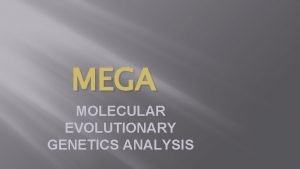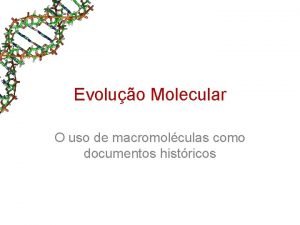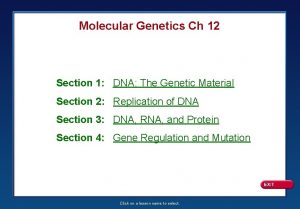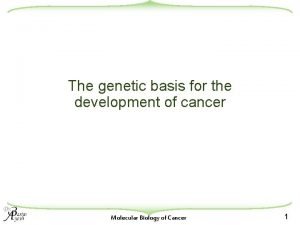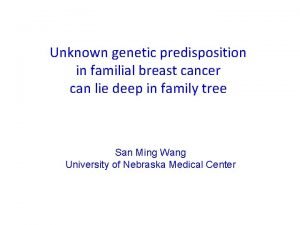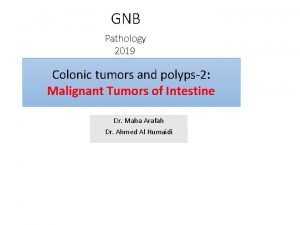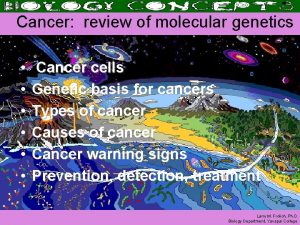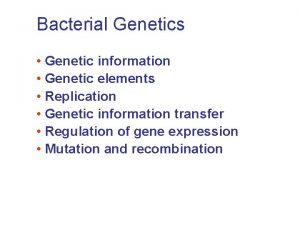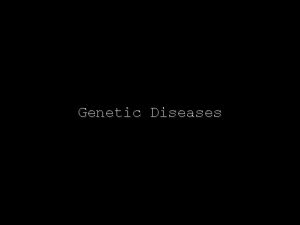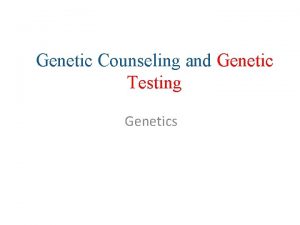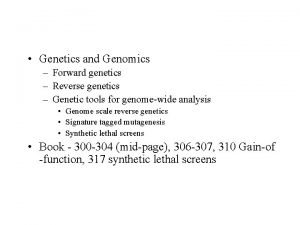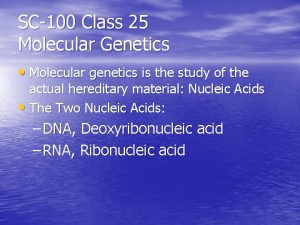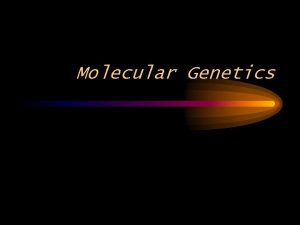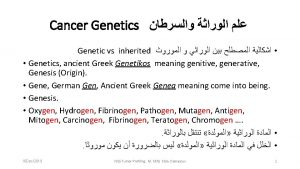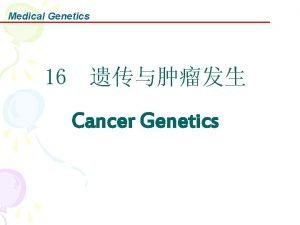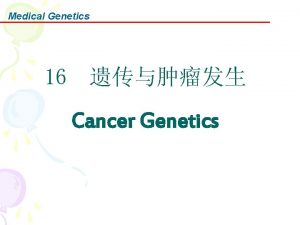Cancer review of molecular genetics Cancer cells Genetic

















- Slides: 17

Cancer: review of molecular genetics • • • Cancer cells Genetic basis for cancers Types of cancer Causes of cancer Cancer warning signs Prevention, detection, treatment Larry M. Frolich, Ph. D. Biology Department, Yavapai College

Characteristics of cancer cells 1. Lack differentiation and do not contribute to body functioning 2. Have abnormal nuclei that are enlarged and may have an abnormal number of chromosomes 3. Unlimited ability to divide • one way is through turning on the telomerase gene that allows telomeres on chromosomes to continually be built thus allowing a cell to divide over and over again 4. Form tumors • Benign tumors are usually encapsulated and do not invade adjacent tissue while a cancerous tumor usually is not encapsulated and eventually invades surrounding tissue 5. Can divide without growth factors 6. Become abnormal gradually through a multistage process 7. Undergo angiogenesis and metastasis Larry M. Frolich, Ph. D. Biology Department, Yavapai College

The 3 phases in the development of cancer cells • Initiation – a single cell undergoes a mutation that causes it to divide repeatedly • Promotion – a tumor develops and cells within the tumor mutate • Progression – a cell mutates in such a way that allows it to invade surrounding tissue Larry M. Frolich, Ph. D. Biology Department, Yavapai College

The genetic basis for cancer • Proto-oncogenes – products promote the cell cycle and prevent cell death (apoptosis) • Tumor-suppressor genes – products inhibit the cell cycle and promote apoptosis • Mutations in the genes above can cause cancer, in fact proto-oncogenes that have mutated are cancer-causing genes called oncogenes Larry M. Frolich, Ph. D. Biology Department, Yavapai College

Comparing these genes in normal and cancer cells Larry M. Frolich, Ph. D. Biology Department, Yavapai College

CANCER QUICK COURSE—WHAT CAN YOU DO TO PREVENT/TREAT? Types of cancer • Oncology – study of cancer • Carcinomas: cancers of the epithelial tissue • Adenocarcinomas: cancers of glandular epithelial cells • Sarcomas: cancers of muscle and connective tissues • Leukemias: cancers of the blood • Lymphoma: cancers of lymphatic tissues Larry M. Frolich, Ph. D. Biology Department, Yavapai College

CANCER QUICK COURSE—WHAT CAN YOU DO TO PREVENT/TREAT? Causes of cancer • Genetics • Environmental carcinogens – Radiation – Environmental carcinogens (tobacco smoke and pollutants) – Viruses Larry M. Frolich, Ph. D. Biology Department, Yavapai College

CANCER QUICK COURSE—WHAT CAN YOU DO TO PREVENT/TREAT? Genetic causes of cancer • Examples of genes associated with cancer: – BRCA 1 and BRCA 2 – tumor-suppressor genes that are associated with breast cancer – RB – a tumor-suppressor gene that is associated with an eye tumor – RET – proto-oncogene that is associated with thyroid cancer • Mutations of these genes predispose individuals to certain cancers but it takes at least one more acquired mutation during their lifetime to develop cancer Larry M. Frolich, Ph. D. Biology Department, Yavapai College

CANCER QUICK COURSE—WHAT CAN YOU DO TO PREVENT/TREAT? Environmental causes of cancer • Radiation: – Environmental factors such as UV light (in sunlight or tanning lights) and x-rays can cause mutation in DNA • Organic chemicals: – Tobacco smoke: increases cancer of lungs, mouth, larynx and others – Pollutants: substances such as metals, dust, chemicals and pesticides increase the risk of cancer • Viruses: – Hepatitis B & C: virus that can cause liver cancer – Epstein-Barr virus: can cause Burkitt’s lymphoma – Human papillomavirus: can cause cervical cancer Larry M. Frolich, Ph. D. Biology Department, Yavapai College

CANCER QUICK COURSE—WHAT CAN YOU DO TO PREVENT/TREAT? Seven warning signs of cancer • • Change in bowel or bladder habits A sore that does not heal Unusual bleeding or discharge Thickening or lump in breast or elsewhere Indigestion or difficulty in swallowing Obvious change in wart or mole Nagging cough or hoarseness Larry M. Frolich, Ph. D. Biology Department, Yavapai College

CANCER QUICK COURSE—WHAT CAN YOU DO TO PREVENT/TREAT? Some routine screening tests for cancer • Self-examination – monthly exams of breasts and testicles starting at age 20 • Colonoscopy – every 5 years starting at age 50 • Mammogram – yearly after age 40 • Pap smear – should begin these 3 years after vaginal intercourse or no later than age 21 Larry M. Frolich, Ph. D. Biology Department, Yavapai College

CANCER QUICK COURSE—WHAT CAN YOU DO TO PREVENT/TREAT? Health Focus: Self exams Larry M. Frolich, Ph. D. Biology Department, Yavapai College

CANCER QUICK COURSE—WHAT CAN YOU DO TO PREVENT/TREAT? Detecting skin cancer • A – asymmetry • B – border is irregular • C – color varies from one area to another • D – diameter is larger than 6 mm Larry M. Frolich, Ph. D. Biology Department, Yavapai College

CANCER QUICK COURSE—WHAT CAN YOU DO TO PREVENT/TREAT? Other ways to detect cancer • Tumor marker tests – blood tests for tumor antigens/antibodies – CEA (carcinoembryonic antigen) antigen can be detected in someone with colon cancer – PSA (prostate-specific antigen) test for prostate cancer • Genetic tests – tests for mutations in proto-oncogenes and tumor-suppressor genes – RET gene (thyroid cancer) – P 16 gene (associated with melanoma) – BRCA 1 (breast cancer) • A diagnosis of cancer can be confirmed by performing a biopsy Larry M. Frolich, Ph. D. Biology Department, Yavapai College

CANCER QUICK COURSE—WHAT CAN YOU DO TO PREVENT/TREAT? Standard cancer treatments • Surgery – removal of small cancers • Radiation therapy – localized therapy that causes chromosomal breakage and disrupts the cell cycle • Chemotherapy – drugs that treat the whole body that kills cells by damaging their DNA or interfering with DNA synthesis • Bone marrow transplants – transplant bone marrow from one individual to another Larry M. Frolich, Ph. D. Biology Department, Yavapai College

CANCER QUICK COURSE—WHAT CAN YOU DO TO PREVENT/TREAT? Newer cancer therapies • Immunotherapy – inject immune cells that are genetically engineered to bear the tumor’s antigens • Passive immunotherapy – antibodies that are linked to radioactive isotopes or chemotherapeutic drugs are injected into the body • p 53 gene therapy – a retrovirus in clinical trial that is injected into the body where it will infect and kill only tumor cells (cells that lack p 53 = tumor cells) • Angiogenesis inhibition - Angiostatin and endostatin are drugs in clinical trials that appear to inhibit angiogenesis Larry M. Frolich, Ph. D. Biology Department, Yavapai College

CANCER QUICK COURSE—WHAT CAN YOU DO TO PREVENT/TREAT? Bioethical focus: Control of tobacco • Food for thought: • Smoking diminishes the health of the smoker and damages nearly every major organ • Within minutes of smoking, a smoker’s body begins to heal • Smoking low-tar or low-nicotine is no different than smoking any other cigarette • The tobacco industry targets young people (9 out of 10 smokers start before age 18) • It is the single most preventable cause of death and disease in the US • Give your thoughts: • Who should pay for the medical bills associated with smoking? • Should the government prevent the sale of tobacco or leave it up to the individual? Larry M. Frolich, Ph. D. Biology Department, Yavapai College
 Chapter 12 section 1 dna the genetic material
Chapter 12 section 1 dna the genetic material Gene pool
Gene pool Genetic programming vs genetic algorithm
Genetic programming vs genetic algorithm Genetic programming vs genetic algorithm
Genetic programming vs genetic algorithm Genetic drift vs gene flow
Genetic drift vs gene flow Genetic drift vs genetic flow
Genetic drift vs genetic flow 14-3 human molecular genetics
14-3 human molecular genetics Chapter 12 section 1: dna: the genetic material
Chapter 12 section 1: dna: the genetic material Chapter 12 molecular genetics
Chapter 12 molecular genetics Molecular evolutionary genetics analysis
Molecular evolutionary genetics analysis Parent genotype
Parent genotype Arvore filogenetica
Arvore filogenetica Molecular genetics chapter 12
Molecular genetics chapter 12 The genetic basis of cancer
The genetic basis of cancer Breast cancer genes
Breast cancer genes Cancer genetic
Cancer genetic Covalent bond melting point
Covalent bond melting point Ionic covalent metallic
Ionic covalent metallic









